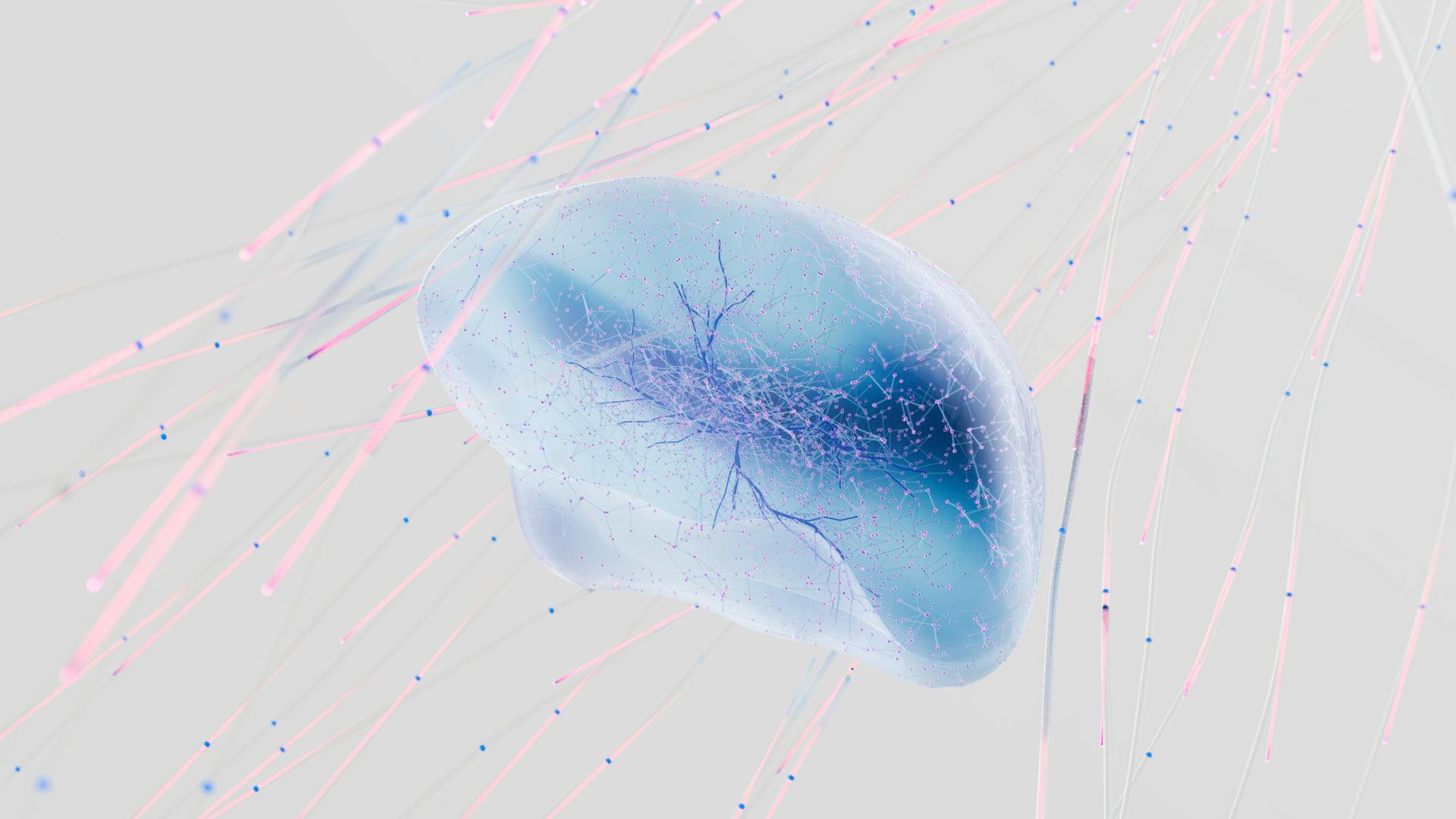
Optimizing machine learning algorithms is a complex task that requires a deep understanding of the underlying techniques. By applying advanced techniques, you can significantly improve the performance of your models.
One key technique is hyperparameter tuning, which involves adjusting the parameters of your algorithm to optimize its performance. This can be done using methods such as grid search or random search.
A well-known example of hyperparameter tuning is the use of Bayesian optimization, which can help you find the optimal combination of hyperparameters for your model. This technique has been shown to be particularly effective in tasks such as image classification.
Regularization techniques, such as L1 and L2 regularization, can also be used to prevent overfitting and improve the generalization of your model.
Check this out: Applied Machine Learning Explainability Techniques
Optimization Techniques
In supervised learning, the goal is to minimize a cost function C, which is the difference between the neural network's prediction and the actual solution. This function is calculated over the entire dataset, taking into account the inputs, predicted values, and actual values.
There are several ways to express the cost function mathematically, including Mean Absolute Error (MAE), Mean Squared Error (MSE), and Root Mean Squared Error (RMSE). These metrics are used to evaluate the performance of the model.
To optimize the model, we can use optimization techniques such as Gradient Descent. This method uses the gradients of the loss function to update the model parameters in a direction that reduces the loss. The loss landscape can give insight into how the model is behaving and how difficult it is to find the minimum loss.
ADAM is a popular choice for training deep neural networks, as it can outperform other optimizers on various tasks. It uses the gradient of the loss function to update the model parameters, but also includes additional terms that allow it to adaptively change the learning rate for each parameter based on the historical gradient information.
The shape of the loss landscape can be challenging to optimize, with many local minima and valleys. However, by using optimization techniques such as Gradient Descent and ADAM, we can find the minimum loss and improve the performance of the model.
Here's an interesting read: Proximal Gradient Methods for Learning
Population-Based
Population-Based optimization is a powerful technique that allows hyperparameters to evolve during the training process. It's an adaptive method that updates hyperparameters on the fly, eliminating the need for manual hypertuning.
This approach is particularly useful in machine learning, where hyperparameters can make a significant difference in model performance. By iteratively replacing poorly performing models with ones that adopt modified hyperparameters and weights, Population-Based Training (PBT) can lead to better results.
One key benefit of PBT is its ability to adapt to changing model performance, making it more efficient than non-adaptive methods that assign a fixed set of hyperparameters for the entire training process. This adaptability is achieved through a process of model warm starting, where the poorly performing models are replaced with new ones that adopt modified hyperparameters and weights.
Here are some key characteristics of Population-Based optimization:
- Adaptive: updates hyperparameters during training
- No assumptions: makes no assumptions about model architecture, loss functions, or training procedures
- Evolutionary: uses a process inspired by biological evolution to search for optimal hyperparameters
By leveraging these characteristics, Population-Based optimization can lead to significant improvements in model performance and efficiency, making it a valuable technique for machine learning practitioners.
Techniques
Machine learning techniques are a crucial part of optimization, and they typically fall within one of three categories: supervised learning, unsupervised learning, and reinforcement learning.
Unsupervised learning is a technique where the algorithm labels the data points for you by organizing the data or describing its structure.
In unsupervised learning, the data points aren’t labeled, and the algorithm generates labels based on similarities discovered between data points.
This technique is useful when you don’t know what the outcome should look like, and it’s often used to create segments of customers who like similar products.
Gradient Descent and Loss Function
Gradient descent is a popular optimization technique used to find the minimum of a loss function, which is a mathematical function that measures the difference between a model's predictions and the actual output.
The loss function is a crucial component of machine learning, and its shape can give insight into how the model is behaving and how difficult it is to find the minimum loss.
A loss landscape is a graph that shows the loss for all possible combinations of the model's parameters. The height of a point on the graph represents the loss for each combination of these parameters.
The training stage of a machine learning model aims to find the combinations of parameters that result in the lowest loss, like finding the lowest point on the loss landscape.
The gradient vector, represented by ∇C, is a multi-dimensional vector that shows the rate of change of the cost function C with respect to each variable x.
To update the model parameters, the gradient descent algorithm uses the gradients of the loss function for the model parameters to update the parameters in a direction that will reduce the loss.
The descent optimization method is used to find the minimum of the loss function, and the loss landscape is a visualization of the loss function in relation to the model parameters.
Here are some key differences between the loss functions:
Stopping Criteria
Stopping Criteria is a crucial aspect of optimizing machine learning algorithms. It's what determines when to stop searching for the optimal hyperparameters.
Irace, a hyperparameter optimization algorithm, uses statistical tests to discard poorly performing configurations, effectively focusing the search on the most promising ones. This approach can significantly reduce the computational cost.
Successive halving (SHA) is another algorithm that periodically prunes low-performing models, directing computational resources towards more promising ones. This helps to optimize the search process.
ASHA, an improvement upon SHA, eliminates the need for synchronous evaluation and pruning, further optimizing resource utilization. This makes it a more efficient approach.
Hyperband is a higher-level algorithm that invokes SHA or ASHA multiple times with varying levels of pruning aggressiveness, making it more widely applicable. It requires fewer inputs, which is a significant advantage.
Suggestion: Computational Learning Theory
Hyperparameter Tuning
Hyperparameter Tuning is a crucial step in optimizing machine learning algorithms. It's the process of finding the best combination of hyperparameters that will result in the best performance of the model.
Grid search is a traditional method for hyperparameter tuning, which involves exhaustively searching through a manually specified subset of the hyperparameter space. This can be time-consuming, especially for complex models with many hyperparameters. Random search, on the other hand, replaces exhaustive enumeration with random selection, allowing for faster exploration of the hyperparameter space.
Bayesian optimization is another powerful method for hyperparameter tuning, which builds a probabilistic model of the function mapping from hyperparameter values to the objective evaluated on a validation set. This allows for efficient exploration of the hyperparameter space and can often outperform grid search and random search.
Hyperparameter tuning can be done using various algorithms, including Grid search, Random search, Hyperband, Bayesian Optimization with Gaussian Processes (BO-GP), Bayesian Optimization with Tree-structured Parzen Estimator (BO-TPE), Particle swarm optimization (PSO), and Genetic algorithm (GA). These algorithms can be used individually or in combination to achieve the best results.
Here's a summary of the different hyperparameter tuning algorithms:
By using the right hyperparameter tuning algorithm, you can significantly improve the performance of your machine learning model.
Frequently Asked Questions
What is the optimization algorithm?
An optimization algorithm is a type of computer program that finds the best possible solution to a problem by minimizing or maximizing a specific objective function. It's a powerful tool used to solve complex problems in fields like business, science, and engineering.
What is an optimizer in machine learning?
An optimizer in machine learning is a function or algorithm that adjusts the neural network's weights and learning rates to minimize loss and improve accuracy. It plays a crucial role in training deep learning models by fine-tuning their performance.
Sources
- https://en.wikipedia.org/wiki/Hyperparameter_optimization
- https://cloud.google.com/ai-platform/optimizer/docs/optimizing-ml-model
- https://www.neuralconcept.com/post/machine-learning-based-optimization-methods-use-cases-for-design-engineers
- https://azure.microsoft.com/en-us/resources/cloud-computing-dictionary/what-are-machine-learning-algorithms
- https://github.com/LiYangHart/Hyperparameter-Optimization-of-Machine-Learning-Algorithms
Featured Images: pexels.com


